Photos are visual stories of our lives, capturing moments we cherish. When upgrading to a new Android phone, the thought of leaving these memories behind is unsettling. Fortunately, transferring photos from Android to Android is a straightforward process with multiple effective solutions.
This comprehensive guide, crafted by the experts at dfphoto.net, delves into six of the best methods for transferring your precious photos between Android devices. Whether you prioritize speed, security, or simplicity, we’ll help you find the perfect way to move your photo library and ensure no memory is left behind.
Method 1: Transfer Photos Locally via PC using Droid Transfer
For those who prefer a hands-on approach and like to manage their photos on a larger screen, using a PC as an intermediary offers robust control and security. Droid Transfer emerges as a powerful tool in this scenario, providing a seamless way to manage and transfer not just photos, but a wide range of Android content.
Droid Transfer operates through a desktop application on your Windows PC and a companion app, Transfer Companion, on your Android device. This combination allows you to access and copy photos, music, contacts, messages, and more, all from your computer. This method provides an excellent way to backup your photos locally and ensures they are not solely reliant on cloud services.
More info on Droid Transfer Free Droid Transfer Download
Here’s how to transfer your photos using Droid Transfer:
- Connect your old Android to your PC: Launch Droid Transfer on your PC and connect your Android device. You can choose to connect via Wi-Fi or USB cable, offering flexibility based on your preference.
- Access Photos in Droid Transfer: Navigate to the “Photos” feature within Droid Transfer. This will display the photos stored on your connected Android device.
- Select and Save to PC: Select the photos you wish to transfer. You can select individual photos or entire albums. Click “Save to PC” and choose a destination folder on your computer to store your photos.
- Connect your new Android: Once the transfer to PC is complete, safely disconnect your old Android and connect your new Android device to your PC.
- Add Photos to New Android: In Droid Transfer, with your new Android connected, go back to the “Photos” feature and click “Add Photos to Device“.
- Choose Photos to Transfer: You can select to add a folder containing all your saved photos or pick specific photos. Choose the photos you previously saved from your old Android that you want to transfer to your new device.
Alt Text: Transferring photos from a PC to a new Android device using Droid Transfer software. The user interface shows the “Add Photos to Device” option highlighted in the Droid Transfer application on a Windows computer.
Droid Transfer also offers a valuable “Export New Photos” feature, simplifying photo backups. It intelligently identifies new photos on your Android that haven’t been backed up to your PC, making regular photo backups effortless and ensuring your memories are always protected.
You can explore Droid Transfer with a free download, which allows you to transfer up to 100 photos. For unlimited transfers and access to all features, a license purchase is available. Droid Transfer is continually updated and supported by a responsive customer service team ready to assist with any questions.
Advantages of Droid Transfer
- Local Photo Storage: Photos are stored locally on your Android devices and your PC, providing secure and offline access.
- Secure and Private: Local transfers are inherently secure, eliminating reliance on internet connectivity and cloud services, enhancing your data privacy.
- Broad Compatibility: Droid Transfer is compatible with Windows 10 and higher PCs and Android devices running Android 5 and up, covering a wide range of devices.
- Comprehensive Android Management: Beyond photo transfer, Droid Transfer provides a suite of Android management tools including exporting, editing, deleting, restoring, and syncing various data types.
- Versatile Content Transfer: It supports transfer of messages, contacts, music, call history, and more, making it a holistic solution for device management.
- Flexible Connection Options: Offers both Wi-Fi and USB cable connection options, catering to different user preferences and scenarios.
- Excellent Value: Provides a robust feature set at a competitive price point.
Disadvantages of Droid Transfer
- Indirect Transfer: Photo transfer is not direct Android-to-Android. It requires an intermediary step of transferring photos to a PC and then from the PC to the new Android.
Method 2: Bluetooth for Direct Android to Android Photo Sharing
Bluetooth, a long-standing wireless technology, remains a viable method for transferring files directly between devices. While it might not be the fastest, it’s universally available and doesn’t require internet access.
Before initiating a Bluetooth transfer, ensure Bluetooth is enabled on both Android devices and that they are paired.
To activate Bluetooth on Android, navigate to Settings > Bluetooth and toggle Bluetooth to ON. On one of the devices, in Bluetooth settings, tap “Pair new device” and select the other Android device to establish a pairing.
Alt Text: Setting up Bluetooth pairing on an Android smartphone. The screen shows the Bluetooth settings menu with the pairing option highlighted.
Here’s how to transfer photos via Bluetooth:
- Open Photos App: Launch the Photos app on the Android device containing your photos.
- Select Photos: Choose the photos you want to transfer. To select multiple photos, long-press on one photo and then tap on additional photos.
- Share via Bluetooth: Tap the Share icon, choose Bluetooth, and then select the paired destination Android device.
- Accept Transfer: On the receiving Android device, you’ll receive a notification to accept the incoming Bluetooth file transfer. Accept the transfer to begin receiving the photos.
It’s important to be aware of Bluetooth security considerations. Bluetooth connections can potentially be vulnerable to security breaches. Adhering to safe Bluetooth practices, such as keeping your devices updated and disabling Bluetooth when not in use, is crucial for security.
Advantages of Bluetooth
- Wireless and Direct: Enables wireless, direct photo transfer between Android devices without needing cables or a computer.
- Local Storage: Photos remain stored locally on your Android devices, maintaining data control and accessibility without cloud dependency.
- Universal Compatibility: Bluetooth is a standard feature in virtually all modern smartphones, ensuring broad compatibility.
- Versatile File Transfer: Bluetooth supports the transfer of various file types including pictures, videos, audio files, and documents.
Disadvantages of Bluetooth
- Slow Transfer Speed: Bluetooth transfers are significantly slower compared to Wi-Fi or USB, making it less efficient for large photo libraries.
- Low Bandwidth: Limited bandwidth makes Bluetooth unsuitable for transferring large files or large quantities of photos.
- Interference and Connection Issues: Bluetooth connections can be prone to interference and pairing issues, potentially leading to interrupted or failed transfers.
- Security Concerns: Bluetooth can present security vulnerabilities if not used cautiously.
Method 3: Leverage Google Photos for Cloud-Based Transfer
Cloud storage offers a convenient and efficient way to manage and transfer photos across devices. Google Photos stands out as an excellent cloud service for Android users, allowing you to store your entire photo library in the cloud, freeing up valuable space on your devices. While Google provides 15GB of free storage shared across Google Photos, Drive, and Gmail, larger libraries might require a Google One subscription for expanded storage.
With Google Photos, your photos are accessible from any device with internet connectivity. This method is not just about transferring photos; it’s about having your photo library readily available across all your devices. You can easily download any photo from Google Photos back to your Android device when needed.
Here’s how to use Google Photos for photo transfer:
- Enable Backup on Old Android: Open Google Photos on your old Android device and ensure you are logged in with your Google account.
- Turn on Backup: Tap your profile picture in the top-right corner, and if “Backup is off,” tap “Turn on backup“.
- Select Google Account: Choose the Google account you will also use on your new Android device.
- Confirm Backup: Tap “Turn on backup“. The initial backup time will vary depending on the size of your photo library and your internet speed. Ensure your device is connected to Wi-Fi for faster and more stable uploads.
- Access Photos on New Android: Once the backup is complete, open Google Photos on your new Android device and sign in with the same Google account.
- View and Download Photos: You will now see all your backed-up photos in the cloud. To download photos to your new Android, select the photo, tap More (three dots), and then Download.
Alt Text: Turning on photo backup to Google Photos on an Android phone. The screen displays the Google Photos settings with the “Turn on backup” option highlighted in red.
Alt Text: Downloading a photo from Google Photos to an Android device. The menu shows the “Download” option highlighted after selecting “More” on a photo.
Advantages of Google Photos
- Fast, Easy, and Wireless: Google Photos provides a quick, user-friendly, and wireless method for managing and accessing photos across devices.
- Flexible Photo Storage: Offers the flexibility to store photos in the cloud, on your Android devices, or both, adapting to different storage preferences.
- Wide Compatibility: Google Photos is supported on all Android devices, as well as iOS devices and computers, offering cross-platform accessibility.
Disadvantages of Google Photos
- Limited Free Storage: The free 15GB of storage can be quickly consumed, especially with high-resolution photos and videos, potentially requiring a paid Google One subscription.
- Scope Limited to Photos and Videos: Primarily designed for photos and videos. Transferring other file types requires Google One or Google Drive.
- Internet Dependency: Accessing and managing photos requires a stable internet connection, which might be a limitation in areas with poor connectivity.
Method 4: Quick Share for Rapid Wireless Transfers
Building upon the concept of Bluetooth sharing, Quick Share (formerly known as Nearby Share) provides a significant upgrade in speed and efficiency for wireless file transfers between Android devices. Developed collaboratively by Google and Samsung, Quick Share intelligently utilizes both Bluetooth and Wi-Fi to optimize transfer speeds, offering a faster alternative to Bluetooth alone.
Similar to Bluetooth, security precautions are important when using Quick Share, as it leverages Bluetooth for device discovery. Keeping devices updated and disabling Bluetooth when not actively sharing is recommended for security best practices. Learn more about Bluetooth security.
Quick Share is supported on devices running Android 6 and higher and is pre-installed on most modern Android devices. For older devices that do not support Quick Share, Android Beam was a predecessor option, though now deprecated.
To use Quick Share, ensure it’s available on both Android devices and that both Bluetooth and Wi-Fi are enabled. Bluetooth is used for discovering nearby devices, while Wi-Fi Direct is used for the faster file transfer itself.
Here’s how to transfer photos using Quick Share:
- Open Photos App: Open the Photos app on your Android device.
- Select Photos: Select the photos you wish to transfer. Select multiple photos by long-pressing and tapping.
- Share and Choose Quick Share: Tap Share at the bottom of the screen and then tap “Quick Share“.
- Device Scanning: Your device will begin scanning for nearby Android devices that have Quick Share enabled and Bluetooth turned on.
- Select Recipient Device: From the list of available devices, select the Android device you want to send your photos to.
- Accept Transfer on Recipient Device: On the receiving device, a notification will appear prompting the user to accept the transfer. Accept the request to start receiving the photos.
Alt Text: Transferring photos from one Android phone to another using Quick Share. The screen shows the share sheet with Quick Share selected and available devices listed.
Advantages of Quick Share
- Wireless and Direct Transfer: Offers wireless and direct photo transfer between Android devices, eliminating the need for cables or computers.
- Local Photo Storage: Photos are stored locally on your Android devices, ensuring data privacy and offline access.
- Broad Compatibility (Android 6+): Supported on a wide range of Android devices running Android 6 and higher.
- Versatile File Transfer: Supports the transfer of photos, videos, audio, and other file types.
- Fast Transfer Speeds: Utilizes Wi-Fi for faster transfer speeds compared to Bluetooth, especially beneficial for larger files or numerous photos.
Disadvantages of Quick Share
- Bluetooth Security Concerns: As Quick Share utilizes Bluetooth for device discovery, the inherent security considerations of Bluetooth apply.
Method 5: Android Beam (NFC) for Proximity-Based Transfer
Before Quick Share, Android Beam was introduced as a method for wireless Android-to-Android file transfer. Launched with Android 4, Android Beam is now deprecated as of Android 10, with Quick Share serving as its successor.
Android Beam uses NFC (Near Field Communication) to establish a connection between two devices. NFC is the same technology used for contactless payments. This technology requires devices to be in very close proximity, often touching, to initiate and maintain data transfer.
To use Android Beam, both devices must support NFC and Android Beam, and these features must be enabled. Settings for NFC and Android Beam may vary by device, often found under “Connected Devices” or “Wireless & Networks” > “More” in the Settings app. Ensure both NFC and Android Beam are turned ON on both devices.
Alt Text: Enabling NFC and Android Beam in the settings menu of an Android phone. The screen shows the “NFC” and “Android Beam” options toggled on.
Here’s how to transfer photos using Android Beam:
- Open Photos App: On the Android device containing your photos, open the Photos app.
- Select Photos: Choose the photos you want to transfer. Select multiple photos by long-pressing and tapping.
- Bring Devices Together: Ensure both Android devices are unlocked and bring the backs of the devices together, aligning their NFC antennas (location varies by device model).
- Tap to Beam: On the sending device, you will see a “Tap to Beam” option appear on the screen.
- Initiate Transfer: Tap the screen to initiate the transfer of your selected photos to the other Android device.
Alt Text: Transferring photos using Android Beam by tapping two Android phones together. The screen shows the “Tap to Beam” prompt on the sending device.
Advantages of Android Beam
- Wireless and Direct Transfer: Provides a wireless and direct method for transferring photos between Android devices.
- Local Photo Storage: Photos are stored locally on the Android devices, maintaining data privacy and direct access.
- Versatile File Transfer: Supports transfer of photos, videos, audio files, and other data types.
Disadvantages of Android Beam
- Limited Compatibility and Deprecation: Supported only on devices running Android 4 through Android 10. It is now deprecated, meaning it’s becoming less relevant as devices upgrade beyond Android 10.
- Proximity Requirement: Requires devices to be in very close contact, which can be cumbersome and can interrupt transfers if the connection is broken.
Method 6: Smart Switch for Seamless Samsung Device Migration
Smart Switch offers a specialized solution tailored for users transitioning to a new Samsung Galaxy device from an older Android phone. This method is particularly useful when upgrading devices and intending to retire the old phone.
Samsung’s Smart Switch app simplifies the migration process, making it easy to transfer a wide range of content from your old device to a new Samsung Galaxy.
- Install Smart Switch: Ensure the Smart Switch app is installed on both Android devices. It typically comes pre-installed on new Samsung Galaxy devices.
- Initiate Receive Data on New Samsung: Launch Smart Switch on your new Samsung Galaxy phone and tap “Receive data” and then “Galaxy/Android“.
- Choose Connection Method: Select your preferred connection method: “USB cable” for a wired connection or “Wi-Fi” for a wireless connection. Follow the on-screen instructions to establish a connection between the two devices.
- Select Content to Transfer: Choose the types of content you want to transfer, including photos, videos, music, messages, and more.
- Start Transfer: Tap “Transfer” to begin the data migration. Once completed, tap “Done“.
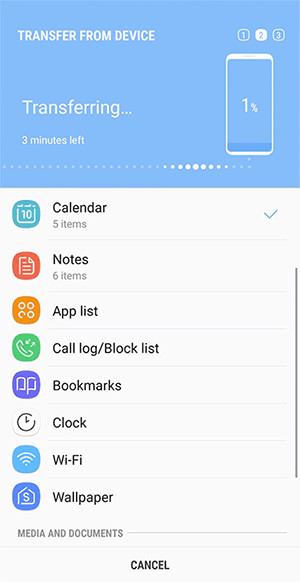 Samsung Smart Switch
Samsung Smart Switch
Advantages of Smart Switch
- Direct Android to Android Transfers: Facilitates direct transfers between Android devices, especially optimized for Samsung to Samsung transfers.
- Flexible Transfer Methods: Supports transfer via Wi-Fi, USB cable, or even using an SD card, offering versatile options.
- Local Photo Storage: Photos remain stored locally on the Android devices, ensuring data privacy and control.
- Comprehensive Content Transfer: Transfers photos, videos, music, messages, apps, settings, and more, providing a complete device migration solution.
Disadvantages of Smart Switch
- Samsung Ecosystem Lock-in: Primarily designed for transferring content to Samsung Galaxy devices, limiting its utility if you’re not migrating to a Samsung phone.
- Compatibility Limitations: While it supports Android devices running 4.3 or later as sending devices, the receiving device must be a Samsung Galaxy phone.
Conclusion: Choosing the Right Photo Transfer Method
This comprehensive guide has presented six distinct methods for transferring photos from Android to Android, each with its unique strengths and weaknesses. The best method for you will depend on your specific needs, priorities, and technical comfort level.
- For users prioritizing security, control, and comprehensive device management, Droid Transfer offers a robust PC-based solution.
- If you need a simple, cable-free, direct transfer for smaller photo collections, Bluetooth is a readily available option, though slower.
- For cloud-based accessibility and backup, Google Photos is an excellent choice, especially for those invested in the Google ecosystem.
- Quick Share provides a faster, more efficient wireless transfer compared to Bluetooth, ideal for quick, direct device-to-device sharing.
- Android Beam, while deprecated, might still be usable on older devices for proximity-based transfers, but is becoming less relevant.
- Smart Switch is the go-to solution for users migrating to a new Samsung Galaxy phone, offering a seamless device migration experience.
By understanding the advantages and disadvantages of each method, you can confidently choose the best way to transfer your cherished photos and ensure your memories move seamlessly to your new Android device.
Publisher: Wide Angle Software
[
Droid Transfer](/droidtransfer/transfer-photos-from-android-to-pc.php)
Transfer photos from Android to Android and easily back up your media to PC.
Related Articles
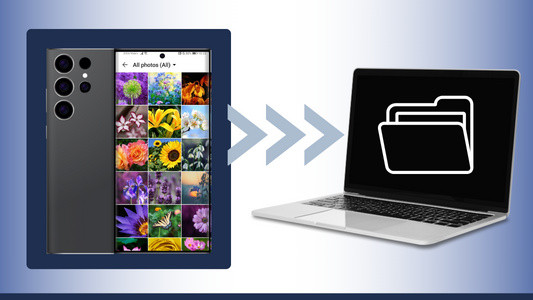 Transfer Photos from Android to PC 4 Easy Ways to Transfer Photos from Android to PC
Transfer Photos from Android to PC 4 Easy Ways to Transfer Photos from Android to PC
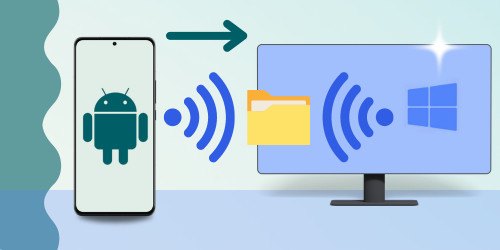 Transfer Files from Android to PC via Wi-Fi 3 ways to transfer files from Android to PC using Wi-Fi
Transfer Files from Android to PC via Wi-Fi 3 ways to transfer files from Android to PC using Wi-Fi
▷Free Download
Droid Transfer X
Easily transfer photos from Android to Android and regularly back up your media using your PC.
Find out more >Try Droid Transfer free, today!
 How to Transfer Data from Android to Android Read Next: How to Transfer Data from Android to Android >
How to Transfer Data from Android to Android Read Next: How to Transfer Data from Android to Android >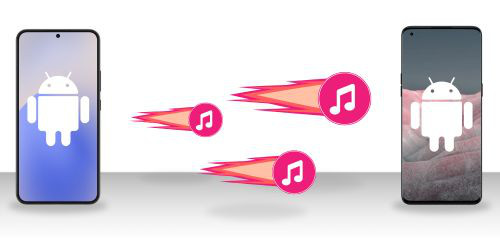 Transfer Music from Android to Android 6 Quick and Easy ways to transfer music from one Android to another
Transfer Music from Android to Android 6 Quick and Easy ways to transfer music from one Android to another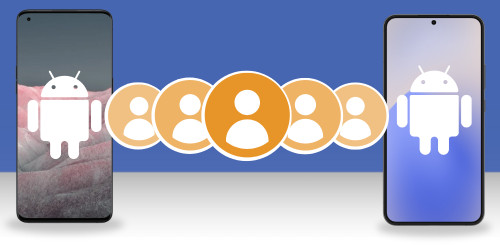 Transfer Contacts from Android to Android The Top 6 Methods to Transfer your Android Contacts to a New Phone
Transfer Contacts from Android to Android The Top 6 Methods to Transfer your Android Contacts to a New Phone